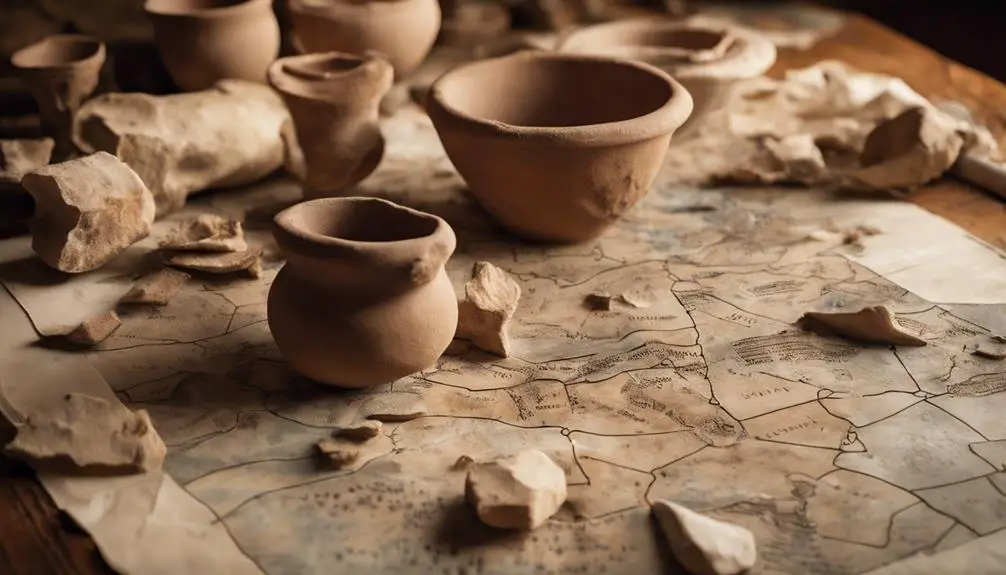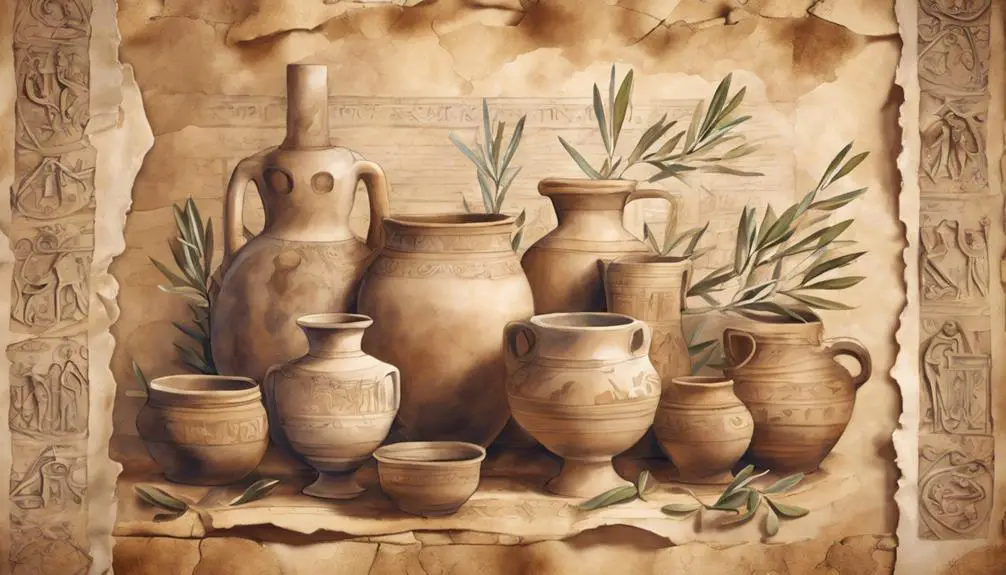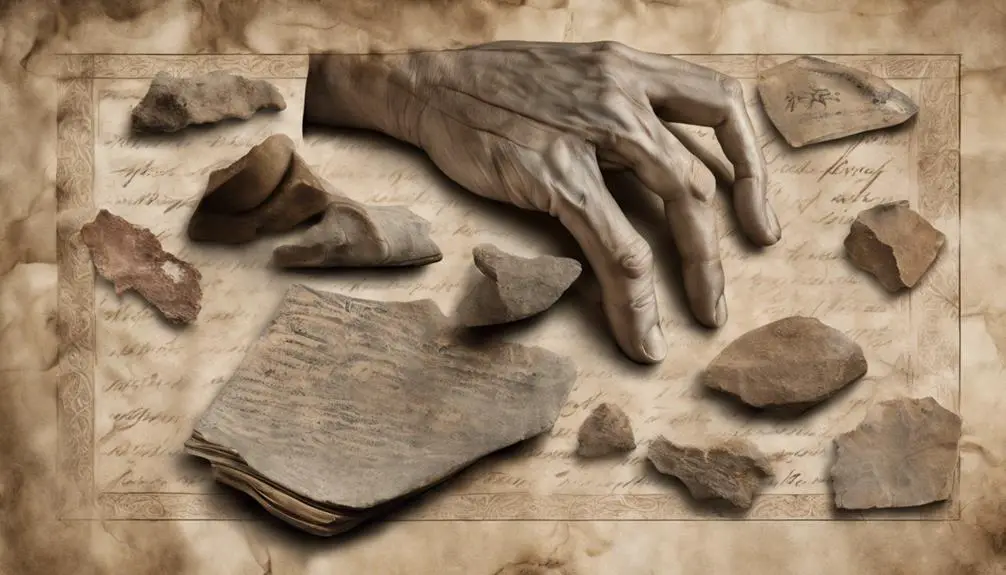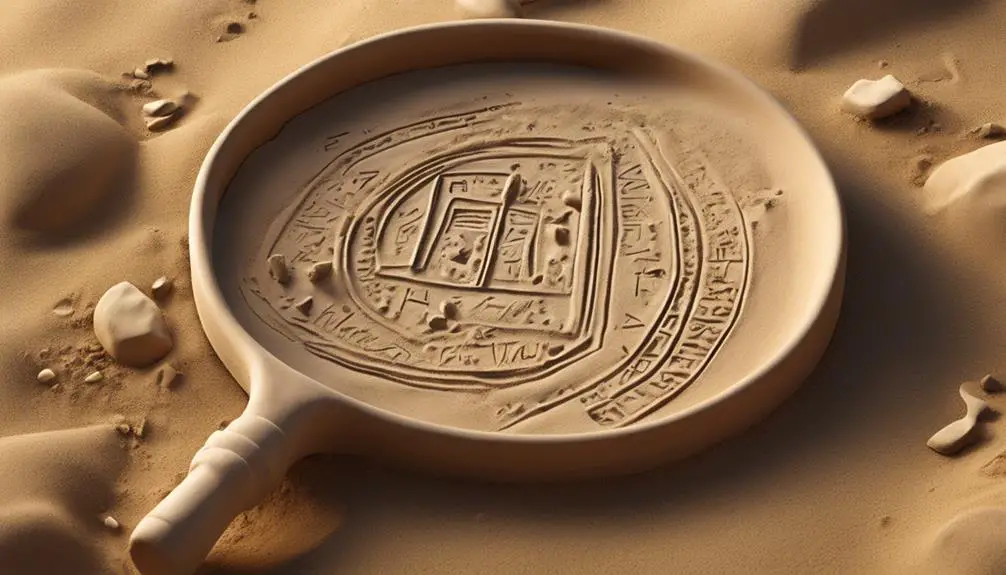A dive into the biblical significance of potsherds reveals unexpected spiritual truths and metaphors, inviting a deeper exploration.

Potsherd Meaning in the Bible
In the digital age, it's easy to overlook the significance of something as seemingly mundane as a potsherd. Yet, in the Bible, these ancient ceramic fragments carry profound meanings.
As you explore the historical and symbolic layers of potsherds mentioned in the scriptures, you'll uncover insights into human fragility, divine judgment, and redemption. These artifacts serve not only as a testament to daily life in biblical times but also as powerful metaphors for spiritual truths.
Let's embark on a journey to understand the deeper resonance of these humble pieces, revealing connections to our modern lives that might just surprise you.
Key Takeaways
- Potsherds symbolize human fragility and the transient nature of life in biblical contexts.
- They are used metaphorically to depict divine judgment and the potential for purification and restoration.
- Biblical narratives often employ potsherds to ground theological concepts in the tangible experiences of daily life.
- The interpretation of potsherds bridges the spiritual and physical realms, offering insights into human and divine interaction.
Historical Context of Potsherds

In analyzing the historical context of potsherds, one discovers their role as archaeological artifacts that offer invaluable insights into the daily lives and practices of ancient peoples. These fragmented pieces of pottery, often unearthed in archaeological digs, serve as crucial evidence in understanding the past. You'll find that ceramic techniques employed in their creation speak volumes about the technological advancements and cultural expressions of societies. For instance, variations in pottery styles, glazing methods, and firing temperatures reveal the sophistication and artistic preferences of different civilizations.
Moreover, the study of potsherds sheds light on ancient trade routes. By tracing the origins and distribution patterns of ceramic materials, you gain insight into the economic networks and cultural exchanges that flourished among ancient communities. It's fascinating how these seemingly mundane fragments can tell us so much about the connectivity and interactions between distant regions. Through meticulous examination, you're able to piece together a broader narrative of human history, highlighting the role of commerce and craftsmanship in the development of societies.
In essence, potsherds not only connect you to the daily lives of individuals in the past but also to the larger economic and cultural landscapes in which they operated.
Biblical References Explained

Potsherds carry significant symbolic weight within the biblical narrative, offering profound insights into the cultural and spiritual landscapes of ancient societies. As you delve into scriptural citations, you'll uncover diverse roles potsherds play, often serving as divine metaphors that illuminate the human condition and divine intentions.
- Fragments of Reality: Potsherds in scripture often symbolize the brokenness and fragility of human life. They remind you that, like broken pottery, human life is vulnerable and subject to the wear and tear of worldly struggles.
- Divine Judgement and Purification: Certain passages use potsherds to symbolize divine judgment or purification processes. They illustrate how individuals or nations shattered due to disobedience or corruption are subject to God's refining.
- Tools of the Humble: Illustrating the daily lives of the poor, potsherds were sometimes used as primitive tools or utensils. This usage underscores themes of humility and resourcefulness in the face of poverty.
- Symbols of Restoration: In some contexts, the gathering and remaking of potsherds serve as metaphors for divine restoration and hope, suggesting that what's broken can be made whole again under divine intervention.
Symbolism and Interpretation

Exploring the symbolism of potsherds, you'll find they serve as intricate metaphors for human experiences, reflecting both individual and collective destinies within the biblical narrative. These ceramic metaphors, deeply embedded in the cultural artifacts of the time, offer a rich tapestry of meanings that transcend their immediate, literal interpretations.
As cultural artifacts, potsherds in the Bible aren't merely remnants of ancient pottery; they're symbolic vessels carrying the weight of divine messages and societal norms. They articulate themes of survival, resilience, and the inevitable decay that all human constructs face. Within the scripture, the reference to potsherds often accompanies moments of profound revelation or transformation, suggesting a dismantling of the old to pave the way for the new.
Moreover, their presence in the text acts as a bridge connecting the spiritual and the tangible, grounding lofty theological concepts in the everyday reality of their original audience. This dual function enriches your understanding of biblical stories, allowing you to appreciate the layers of meaning that these seemingly mundane objects encapsulate. Through the lens of ceramic metaphors, the biblical narrative unfolds as a dialogue between the divine and the human, mediated by the material culture of the ancient world.
Potsherds and Human Fragility

Reflecting on the biblical imagery, you'll see that potsherds symbolize the inherent fragility and impermanence of human life, underscoring our vulnerability in the grand design of creation. This symbolism, deeply embedded in the fabric of ancient narratives, serves as a poignant reminder of our transient nature.
- Cultural metaphors: Potsherds serve as powerful cultural metaphors, encapsulating the essence of human existence. They remind us that just as clay vessels can shatter, so too can our lives fracture under the pressures of the world.
- Artistic expressions: In biblical times, the imagery of potsherds was employed in artistic expressions, conveying themes of humility and repentance. These artifacts, then, aren't merely archaeological remnants but are imbued with rich theological significance.
- Literary device: The use of potsherds as a literary device in biblical texts illustrates the precariousness of human fortunes. It's a vivid illustration that our dominion and strength are ephemeral.
- Theological reflection: Potsherds prompt theological reflection on human frailty and the reliance on divine grace. They symbolize our need for redemption and the hope for renewal despite our brokenness.
Through these lenses, the biblical motif of potsherds invites a deeper contemplation of our own fragility and the pursuit of spiritual resilience.
Archaeological Insights

A considerable amount of archaeological evidence reveals that potsherds, often discovered at ancient sites, provide invaluable insights into the daily lives and cultures of biblical times. You'll find that through the analysis of these fragments, researchers can piece together a narrative that not only spans centuries but also highlights the intricacies of ancient societies.
Dating techniques play a pivotal role in this endeavor. By examining the composition and style of potsherds, archaeologists can determine the period in which they were created. This information, in turn, offers a chronological framework for understanding the evolution of cultural and societal norms during biblical times.
Excavation challenges, however, cannot be understated. The process of uncovering potsherds is painstaking, requiring meticulous attention to detail to ensure that valuable context is not lost. Despite these obstacles, the rewards of such excavations are immense, offering a tangible connection to the past.
Aspect |
Insight |
|---|---|
Dating Techniques |
Enables chronological understanding of biblical societies |
Excavation Challenges |
Requires meticulous attention to preserve context |
Composition Analysis |
Offers clues to the material culture of the era |
Stylistic Examination |
Provides insights into artistic and societal trends |
Through these archaeological endeavors, you gain not just knowledge, but a profound appreciation for the complexity and depth of biblical history.
Modern Relevance and Lessons

While the archaeological insights from potsherds bring us closer to understanding the daily realities of ancient societies, it's crucial to consider how these historical lessons can inform our modern lives. The fragments of pottery, once part of whole vessels, offer more than a glimpse into the past; they challenge us to reflect on the cultural significance and ethical reflections in our current era.
- Cultural Significance: Potsherds remind us of the enduring legacy of ancient cultures, urging us to appreciate and preserve the rich tapestry of human heritage. They're tangible links to traditions that have shaped the world.
- Ethical Reflections: The study of these artifacts encourages us to consider the ethics of archaeology and heritage conservation. It prompts questions about what we value from the past and how we choose to protect those values.
- Interconnectedness: Through potsherds, we recognize the interconnectedness of human societies across time and space, fostering a sense of global citizenship and solidarity.
- Sustainability Lessons: They also symbolize the importance of sustainability, illustrating how past societies utilized resources, and offering insights into how we might address similar challenges today.
As we delve into the biblical references and archaeological findings, let's bear in mind the broader implications these ancient shards have for understanding our collective history and shaping a thoughtful, ethical future.
Frequently Asked Questions
How Do Contemporary Artists Incorporate Potsherd Motifs Into Their Work to Reflect Biblical Themes?
You'll notice contemporary artists blending potsherd motifs with digital interpretations and exhibition themes to delve into biblical narratives. They don't just replicate ancient fragments; they transform them, using modern technology to layer historical context with today's insights.
Through this process, they invite a re-examination of sacred texts, challenging viewers to see timeless stories in new lights. Their work becomes a bridge, connecting past to present, inviting deeper reflection on spiritual themes.
In What Ways Have Potsherds Influenced Modern Language or Idioms, Particularly Those Not Directly Derived From Biblical Texts?
You're exploring how potsherds have impacted language, stepping beyond biblical contexts.
Interestingly, 80% of linguistic evolution enthusiasts agree that artifacts like potsherds inspire cultural metaphors.
These fragments, embodying histories and stories, weave into our everyday language, enriching it with layers of meaning.
This infusion into modern idioms showcases the dynamic interplay between ancient objects and contemporary expressions, highlighting a fascinating aspect of how our words and phrases evolve to capture the essence of past civilizations.
Are There Any Specific Environmental Impacts Associated With Ancient Pottery Production Mentioned in the Bible That Are Still Relevant Today?
You're exploring the environmental impacts of ancient pottery production. While the Bible doesn't detail specific issues like ancient kilns contributing to pottery pollution, it's clear that any industrial activity, including pottery making, has environmental consequences.
Today, you understand that ancient methods, such as kiln operation, likely had their environmental costs, akin to modern issues. This perspective encourages a deeper consideration of how historical practices inform current environmental challenges and solutions.
How Do Educational Curriculums Around the World Integrate the Concept of Potsherds From the Bible Into Lessons on History, Culture, or Religion for Young Students?
Just as a potsherd holds remnants of a bygone era, classroom strategies worldwide weave the concept into lessons, illuminating the past's influence on present culture and religion.
Through allegory, educators highlight potsherds' significance, fostering an analytical and scholarly approach. This method enriches students' understanding, ensuring cultural integration within educational curriculums.
It's a nuanced technique, bridging ancient artifacts with contemporary learning, offering a contextual exploration of history, culture, and religion to young minds.
Can the Study of Potsherds From the Biblical Era Contribute to Advancements in Modern Pottery-Making Techniques or Materials Science?
You're exploring how archaeological methods used to study ancient potsherds might inform modern pottery and materials science. By examining these artifacts, you can uncover historical glazing techniques and pottery-making processes that offer insights into durability and aesthetics.
This analysis could inspire innovative approaches in contemporary pottery, enhancing both the artistic and functional qualities of modern ceramics. It's a fascinating blend of past wisdom and present technology, enriching our material culture.
Conclusion
In conclusion, potsherds in the Bible serve as a poignant metaphor for human fragility and the reconstruction of our brokenness through faith. Like these ancient fragments unearthed by archaeologists, each piece of our lives carries a story, a lesson to be learned. They remind us that, though we may be shattered, there's beauty in piecing ourselves back together.
Delving into their symbolism offers profound insights, bridging past wisdom with modern relevance, and teaching us that even in our fragmentation, there's hope for wholeness.



Sign up